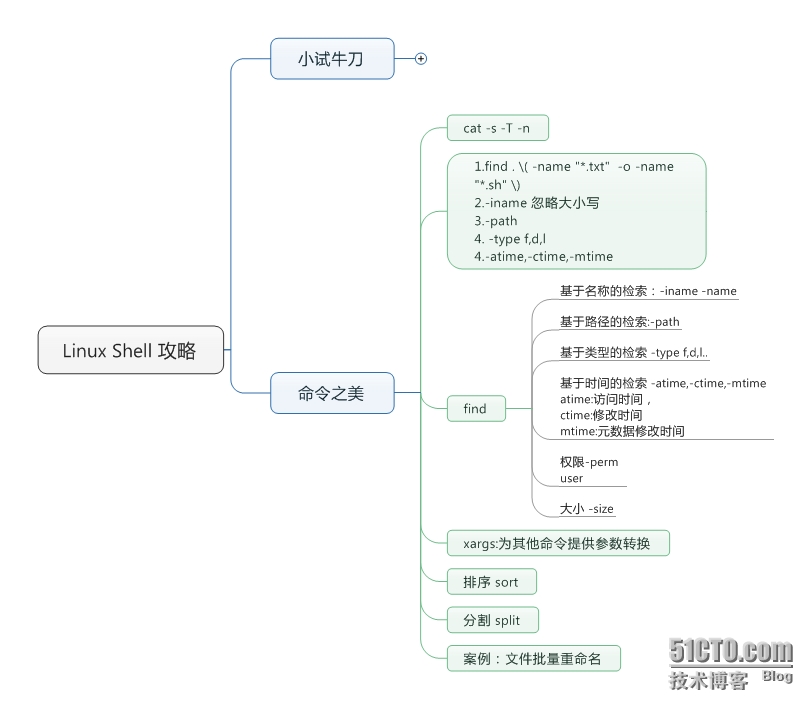原创作品,允许转载,转载时请务必以超链接形式标明文章
原始出处 、作者信息和本声明。否则将追究法律责任。
http://dba10g.blog.51cto.com/764602/1607658
介绍一些常用的命令
cat命令一些用法
|
1
2
3
4
5
6
7
8
9
10
11
12
13
14
15
16
17
18
19
20
21
22
23
24
25
26
27
28
29
30
31
32
33
34
35
36
37
38
39
40
41
42
43
|
#cat -s命令压缩空行
[root@beijing
test
]
# cat catinfo.txt
1
2
3
4
5
100
[root@beijing
test
]
# cat -scatinfo.txt
1
2
3
4
5
#输出行号
[root@beijing
test
]
# ls | cat -n
1 1.txt
2 2.txt
3
cal
.sh
4 catinfo.txt
5 cmd.sh
6
date
.sh
7 func.sh
8 index.sh
9 menu.sh
10 output.session
#-T: tab键^显示
[root@beijing
test
]
# cat catinfo.txt
public class A{
System.out.println(
"helloshell"
);
}
[root@beijing
test
]
# cat -Tcatinfo.txt
^Ipublic class A{
^I^ISystem.out.println(
"helloshell"
);
^I}
|
终端回放
|
1
2
3
4
|
#所谓的终端回放,就是捕捉终端命令历史
#可以使用script命令
script -t 2> timing.log -aoutput.session
#注意需要关闭终端,才会保存timing.log
|
文件查找
|
1
2
3
4
5
6
7
8
9
10
11
12
13
14
15
16
17
18
19
20
21
22
23
24
25
26
27
28
29
30
31
32
33
34
35
36
37
38
39
40
41
|
#区分大小写
[root@beijing
test
]
# find . -name"f*.sh"
.
/func
.sh
#不区分大小写
[root@beijing
test
]
# find . -iname"f*.sh"
.
/func
.sh
.
/FUNC
.SH
#基于路径查询(其实就是对路径进行完整匹配,不要考虑什么层级关系,把路径当成字符串处理)
[root@beijing ~]
# find /etc -path"etc/*sysconfig/*network"
[root@beijing ~]
# find /etc -path"*etc/*sysconfig/*network"
/etc/sysconfig/networking/profiles/default/network
/etc/sysconfig/network
#文件类型查找
#查找文件
[root@beijing
test
]
# find -type f
.
/out
.txt
.
/index
.sh
.
/cal
.sh
.
/catinfo
.txt
.
/func
.sh
#查找目录
[root@beijing
test
]
# find -type d
.
.
/aaa
基于时间的查找(atime:访问时间,ctime:变化时间,mtime:修改时间)。这里的变化指的是“元数据”,比如权限、用户名什么的。
#访问时间超过七天
find
-atime +7
#七天前被访问过的文件
find
-atime 7
最近七天访问过的文件
find
-atime -7
基于权限
find
-perm
基于大小,支持单位cwbkMG
find
-size
-size n[cwbkMG]
|
xargs
|
1
2
3
4
5
6
7
8
9
10
11
12
13
14
15
16
17
18
19
20
21
22
23
24
25
26
27
28
29
30
31
32
33
34
35
36
37
38
39
40
41
42
43
44
45
46
47
|
#多行 换成单行
[root@beijing
test
]
# cat xargs.txt
1.txt
2.txt
3.txt
4.txt
[root@beijing
test
]
# cat xargs.txt |xargs
1.txt 2.txt 3.txt 4.txt
#单行 换成多行
[root@beijing
test
]
# cat xargs1.txt
1 2 3 4 5 6 6 8 9 10
[root@beijing
test
]
# cat xargs1.txt|xargs
1 2 3 4 5 6 6 8 9 10
[root@beijing
test
]
# cat xargs1.txt|xargs -n 2
1 2
3 4
5 6
6 8
9 10
#指定分界符【其中1,2,3,4之间就是用tab键分割的)
[root@beijing
test
]
# cat xargs1.txt|xargs -n 2 -d "\t"
1 2
3 4
5 6 6 8 9 10
#测试shell, 仅仅打印参数
[root@beijing
test
]
# cat sayparam.sh
#!/bin/bash
echo
"$*"
#;
#模拟参数文件
[root@beijing
test
]
# cat argums.txt
param1
param2
param3
[root@beijing
test
]
# cat argums.txt|xargs -n 2 sh sayparam.sh
param1 param2
#
param3
#
[root@beijing
test
]
# cat argums.txt|xargs -n 1 sh sayparam.sh
param1
#
param2
#
param3
#
[root@beijing
test
]
# cat argums.txt|xargs sh sayparam.sh
param1 param2 param3
#
|
排序
|
1
2
3
4
5
6
7
8
9
10
|
#-k 排序键,从1开始
#-r:反序,就是从大到小
[root@beijing
test
]
# cat argums.txt| sort -r -k 1
param3
param2
param1
[root@beijing
test
]
# cat argums.txt| sort -k 1
param1
param2
param3
|
分割文件
|
1
2
|
split
可指定生成文件前缀,序号是按数字排列,还是字母排列,分割大小。
|
案例 批量修改某文件夹文件名称
|
1
2
3
4
5
6
7
8
9
10
11
|
#!/bin/bash
for
file
in
*.txt;
do
filename=${
file
%\.*}
#文件名,非贪婪,从右到左匹配
extention=${
file
##*.}#获取后缀名,贪婪从左到右匹配
result=$filename\_back.$extention;
mv
$
file
$result 2>
/dev/null
;
if
[[ $? -
eq
0 ]];
then
echo
"rename $file success"
fi
done
|
本文出自 “简单” 博客,请务必保留此出处http://dba10g.blog.51cto.com/764602/1607658






















 392
392











 被折叠的 条评论
为什么被折叠?
被折叠的 条评论
为什么被折叠?








